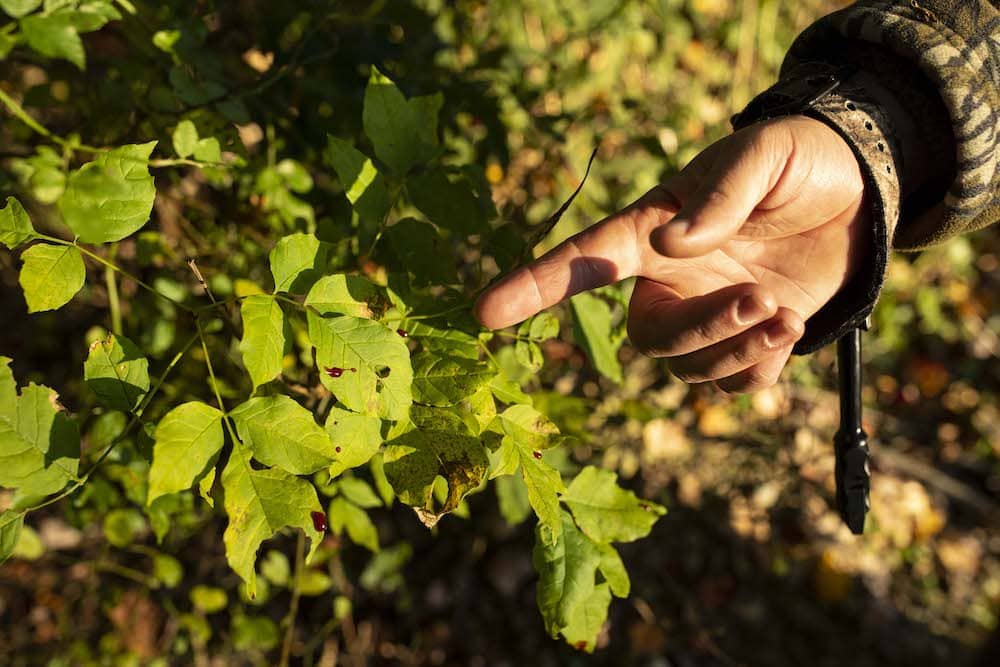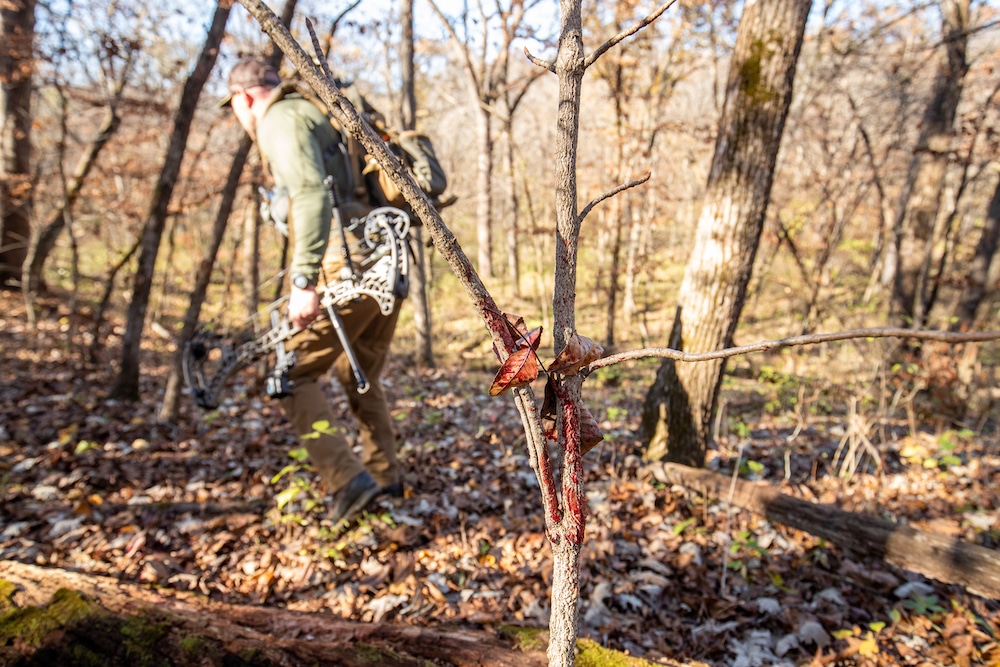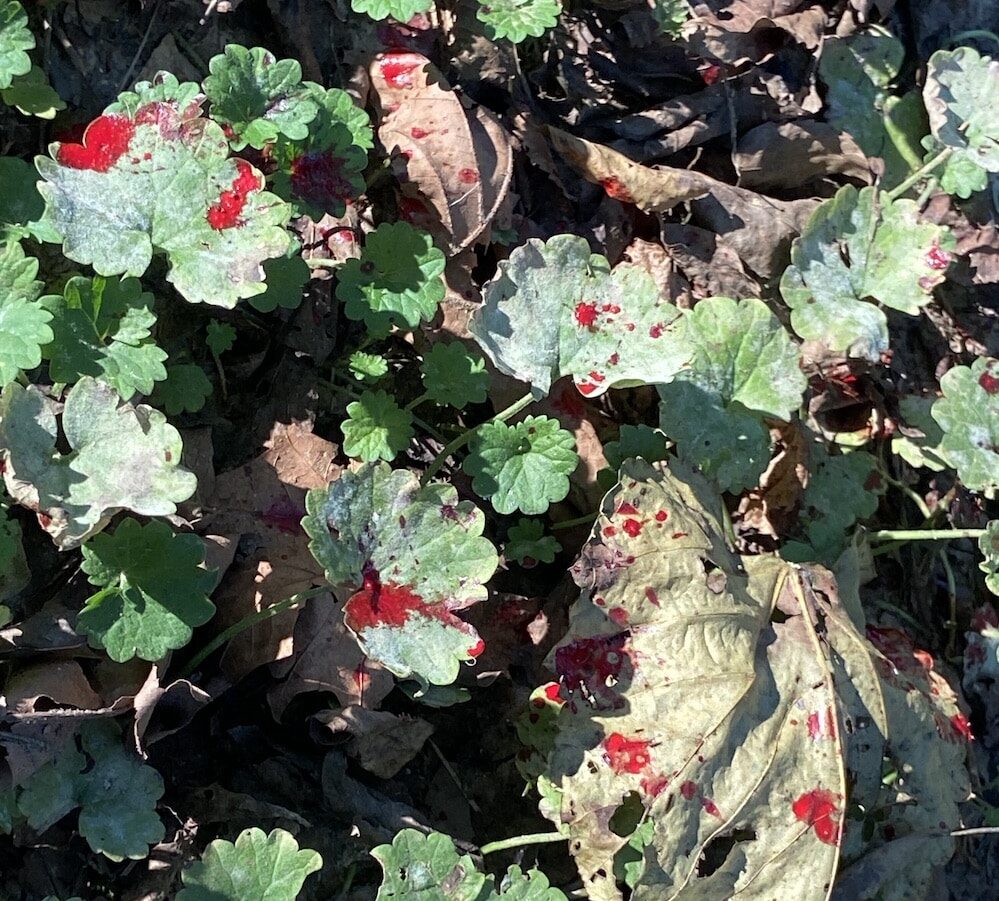The plan worked perfectly. After hours of studying maps and applying trail camera intel to devise a strategy for your target buck, the hunt finally culminated with him broadside at 23 yards. You heard the shot hit its mark, but you didn’t see the buck fall dead, and the low-light conditions made it difficult to know how to proceed. Sound familiar? In these circumstances, reading sign and understanding the types of blood associated with different shot locations is critical to recovering your deer.
Reading the signs left behind by a wounded deer is a skill every bowhunter needs to learn. The moments following a shot are not just about excitement; they are about making informed decisions that can lead to a swift recovery. Different shot locations produce different types of blood, each requiring a unique approach to maximize the chances of a successful recovery. It’s easy to get mentally overwhelmed after releasing an arrow, but it’s critical to slow down, note any key landmarks, and monitor the deer’s behavior before picking up the trail.
Lung blood, bright red and frothy, tells the tale of a well-placed shot through the chest cavity. Large, foamy bubbles in the blood are a classic indicator your arrow passed through both lungs. Such a shot deflates both lungs, often resulting in a quick, clean kill and generally short blood trail. If the shot is perfectly broadside and the arrow passes through completely, give the deer at least 30 minutes before picking up the track.
However, not all lung shots are equal. Steeply angled shots quartering toward or away from your location can lead to a single-lung hit, which is not always fatal. Single-lung hits will produce similar sign to a double-lung hit, but the deer will travel much farther. Generally speaking, if the deer travels more than 150 yards on a suspected lung shot, it’s unlikely both lungs have deflated. Unfortunately, deer can live for long periods with just one operable lung. If you suspect your shot was a single-lung hit, wait two to four hours for the deer to bed down. Then, pick up the trail slowly during shooting hours, always keeping your eyes peeled up ahead. In these situations, locating the deer in its bed and stalking into position for a follow-up shot can be the difference between venison in the freezer or a frustrating offseason.

Arrows to the heart will generally produce a thick, bright red blood. Photo Credit: BU
The heart is in the lower third of the chest cavity, tucked behind the armpit. Many seasoned bowhunters aim for the top of the heart, just below the bottom of the lungs. If the deer doesn’t budge at the sound of the shot, the arrow will pass through the heart. If the deer attempts to “jump the string,” you’ll likely hit the lungs, offering a large, forgiving vital area. Heart shots produce heavy, bright red blood. They’re always fatal, and the deer will rarely travel more than 125 yards from the shot. Since the heart sits farther forward than the lungs, it isn’t uncommon for the arrow to impact the off-side shoulder or leg, preventing a complete pass through. In these situations, the front legs will typically be rendered useless and the deer will “snowplow” for a few yards, resulting in a very short tracking job and very clean kill.

Arrows to the liver will be dark red. Photo Credit: Erik Barber
Dark red blood free of bubbles signifies a liver hit. While liver shots are always fatal, they require time—sometimes eight hours or more—for the deer to expire. In these situations, patience is critical. Liver-hit deer often run a short distance before bedding down. It’s critical to avoid bumping the deer after it beds down. Carefully exit the area where you shot the deer and allow for at least six hours to pass before returning. Most liver-hit deer will be dead in their first bed location when they’re not disturbed after the shot.
The guts are located in the abdomen, the bulging midsection forward of the rear legs. Deer hit in the guts usually hunch their back and slink away slowly after the shot, similar to a scolded dog. Similar to liver hits, gut shots are always fatal, but difficult to track. Arrows coated in smelly brown or green fluid are indicative of a gut shot. Blood can be hard to find, since intestines can plug entry and exit holes, causing most of the bleeding to occur internally. Where legal, tracking dogs tremendously increase the odds of recovering a gut-shot deer. Wait at least 12 hours before picking up the track, and do your best to move slowly and stay focused on any sign left from the deer. Deer hit in the guts will sometimes head toward water sources, so if blood dries up, these can be productive areas to search. Don’t give up if you run out of blood and the track goes dry. If needed, grid-search the area, listen for coyotes, and watch for circling vultures, all of which are signs of a dead deer in the area.

Hits to the muscle will produce blood similar to the heart and lungs. Photo Credit: Will Brantley
Muscle blood can resemble heart or lung blood at first, but it quickly dissipates. Unlike other shots, a muscle hit requires immediate tracking: A broken leg or shoulder can slow a deer down, and pushing it will prevent blood from clotting and drying out. Deer can completely recover from muscle hits, but if you can stay on the track and locate it bedded, you may be able to sneak into bow range for a follow-up shot.
In the aftermath of a shot, it’s vital to slow down and make careful observations. Take mental notes and mark the deer’s location and where you last saw it moving. I use my finger in the frame of a quick photo on my phone to mark the shot location from the treestand and where I last saw the deer. Be mindful of any unique features, such as downed logs, fence crossings, or anything that stands out as the deer runs away. Once I get down to pick up the trail, I reference the photo to make sure I’m in the right spot. Each blood trail tells a story, and understanding what it says is the key to a successful recovery.